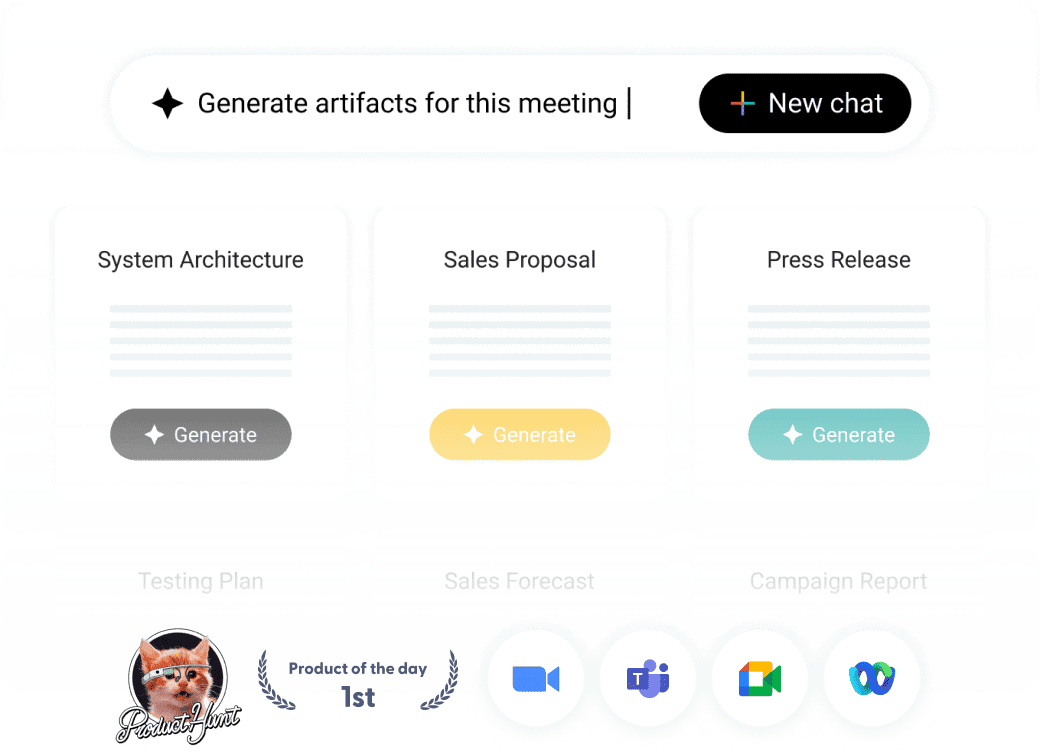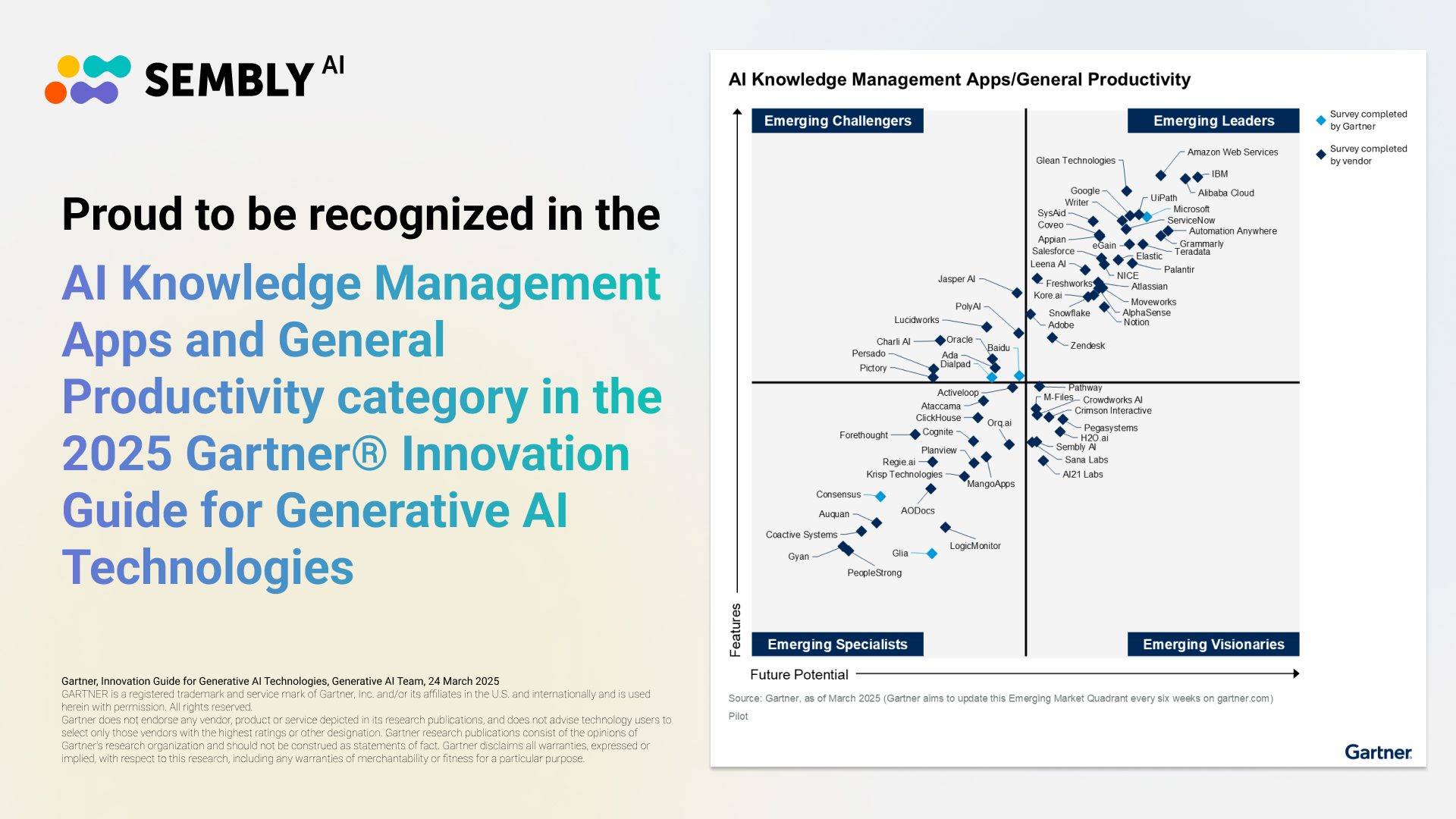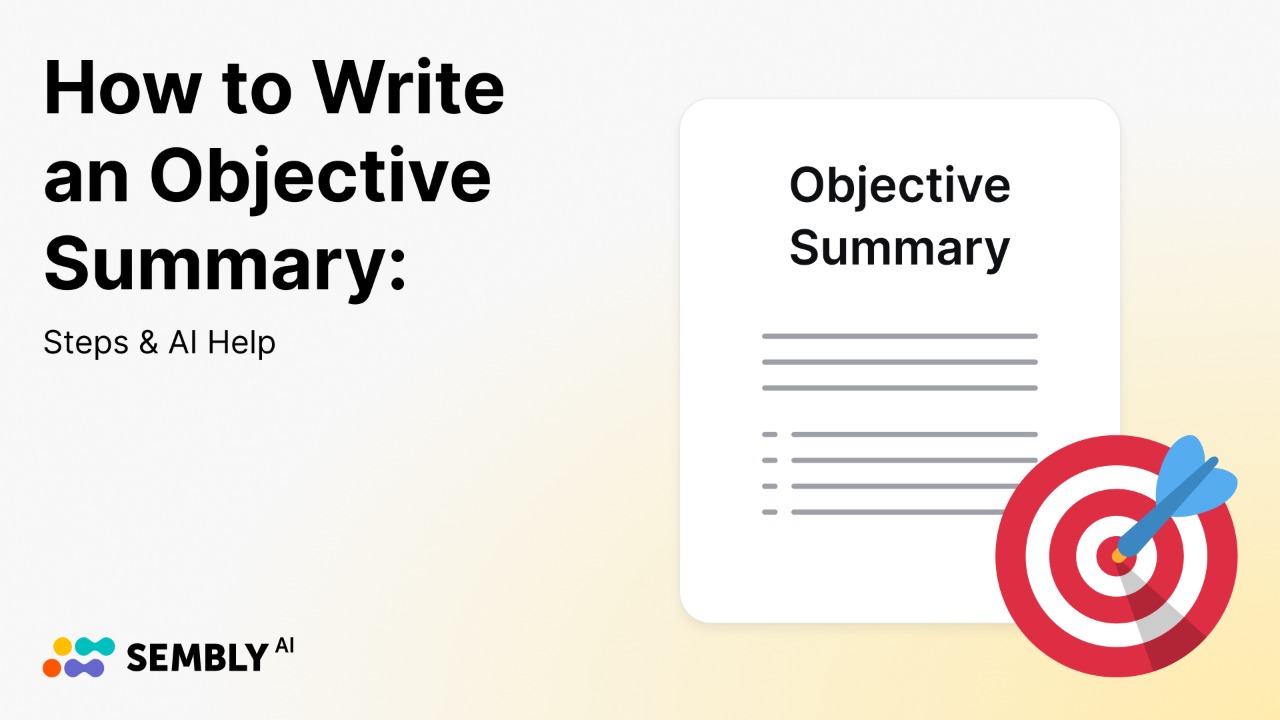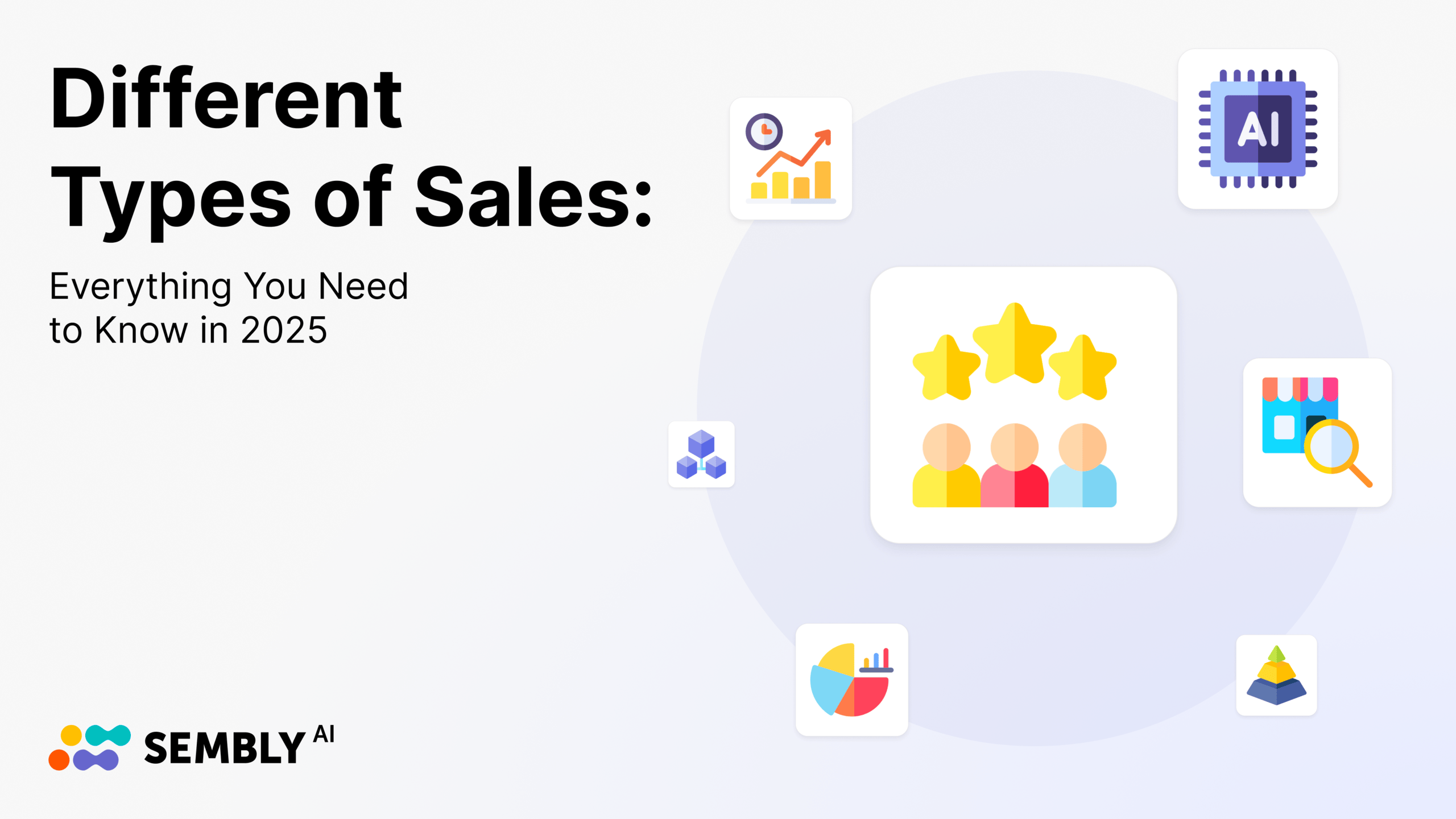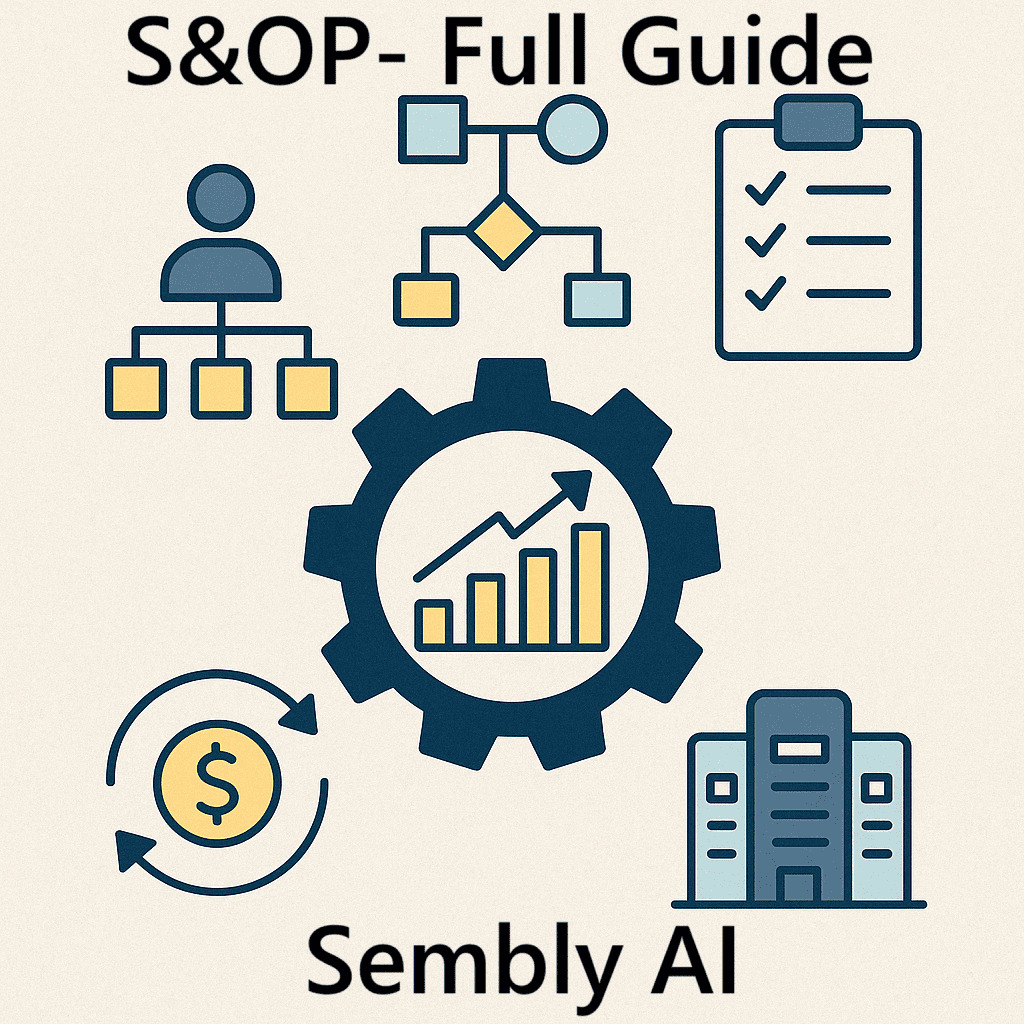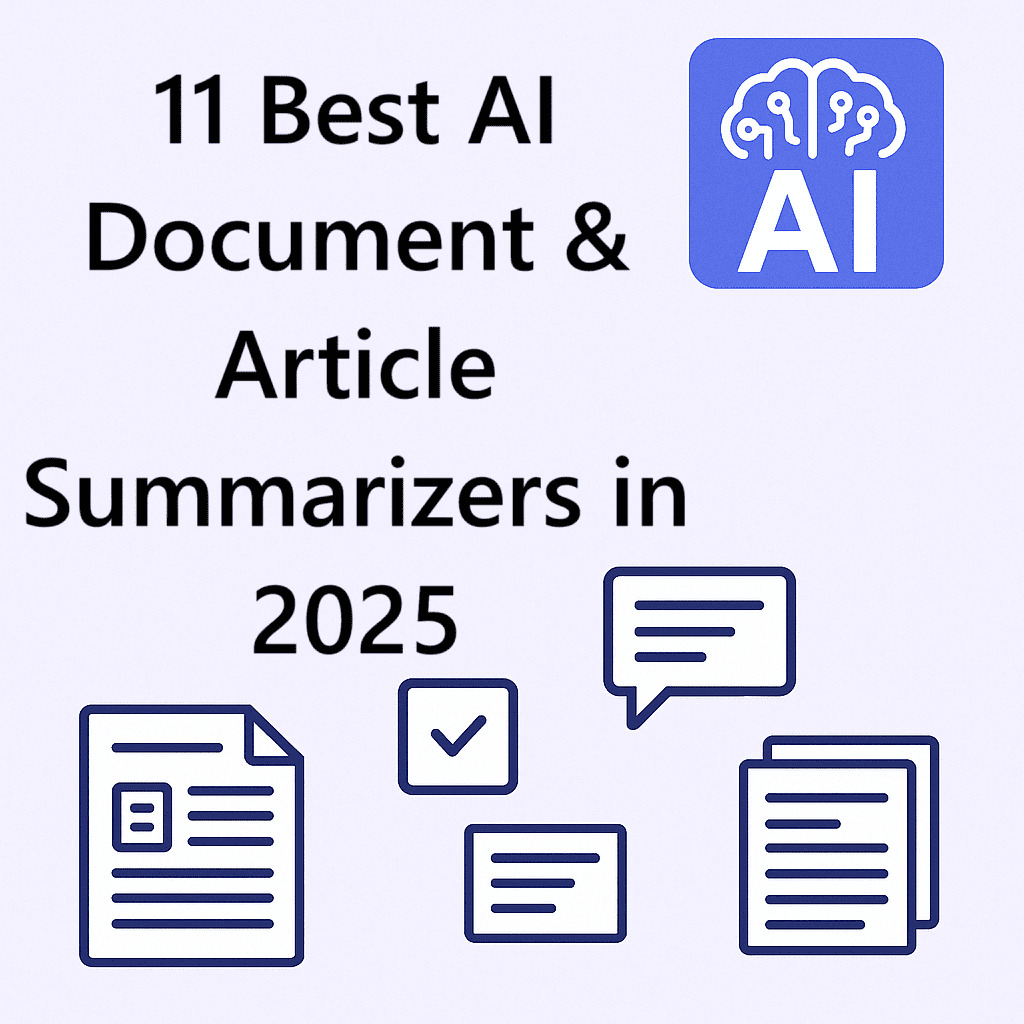Table of Contents
ToggleRecently updated on March 24th, 2025
AI has completely reshaped the way various businesses handle information in 2025. Tools available nowadays help cut down on manual work, reduce errors, and significantly speed up data processing. This is quite a predictable phenomenon, as companies deal with more data than ever before. However, in this situation, finding the right data automation tools has become crucial for staying competitive.
But what exactly can data automation do for your business? Looking ahead, we have to say the benefits are significant, from basically streamlining repetitive tasks to ultimately uncovering valuable insights hidden in massive data arrays. At the same time, with so many options available in the modern AI market, choosing the one that best fits your needs can be quite challenging for virtually any business, no matter the previous experience with AI or automation. For this exact purpose, we created our guide that explores the top 11 data automation solutions in 2025, helping you find the tool you’re looking for among the best. So, without further ado, let’s go!
What is Data Automation?
But first things first. Let’s take a brief look at the concept itself. Basically, data automation is the process of using technology to handle data-associated tasks with minimal or no human input from businesses. Data automation typically involves setting up system software solutions that can collect, process, analyze, and save data on their own. Generally, this process is akin to teaching computers to perform the repetitive tasks that humans used to do manually.
Why does this matter? Data automation frees up time for actual people to focus on more important tasks, not to mention the significant cost-efficiency opportunities provided by the automation of data processes. Another, less obvious advantage of using data automation solutions over manual efforts is that they reduce human errors that often come with manual data entry. This means that businesses can make faster decisions based on more accurate sets of information. From sales to customer analytics, modern data automation tools affect many parts of business processes.
What Are the Components of Data Automation?
Data automation software typically consists of several key parts working together. These components handle different stages of the data lifecycle from gathering information to presenting insights. Here are some of them:
- Data collection: Gathering data from various sources;
- Data storage: Storing collected data firmly;
- Data cleaning: Removing errors and inconsistencies;
- Data integration: Combining data from different sources;
- Data processing: Transforming raw data into formats useful for your business processes;
- Data analysis: Extracting insights from processed data;
- Reporting and visualization: Presenting findings in clear visual formats;
- Workflow automation: Coordinating tasks across the data pipeline;
- Scheduling: Timing data tasks to run at specific intervals;
- Monitoring and alerts: Tracking system performance and flagging issues.
What Are Data Automation Tools?
Data automation tools are software solutions specifically designed to streamline and optimize data-related tasks. These tools handle various components of data management that we have mentioned previously. The list of these tools ranges from simple Python-based scripts to complex platforms with visual interfaces that can offer functionalities even broader than the list of data automation components mentioned above. Some tools focus on specific tasks like data cleaning or visualization, while others offer end-to-end solutions for entire data pipelines. Good data automation tools can completely transform how your business handles information, but what should you look for when choosing a tool?
What to Look for in a Data Automation Tool?
Ease of Use
You probably want to find a tool with an intuitive interface. It should be easy for both technical and non-technical users to navigate and operate.
Scalability
Any business owner wants to choose a tool that can grow alongside their business. It should handle increasing data volumes and complexity without slowing down.
Integration Capabilities
The tool should seamlessly connect with your existing systems. Look for pre-built connectors to common databases, apps, and platforms you use in your operations.
Security Measures
Data protection is crucial. Check for encryption, access controls, and compliance with relevant data regulations.
Customization Options
Every business has its own unique business objectives. Good data automation tools should allow custom workflows and rules to fit your specific processes.
Support and Documentation
Choose a tool with robust support options. Good documentation and an active user community can help you solve problems quickly.
Best 11 Data Automation Tools
1. Sembly AI
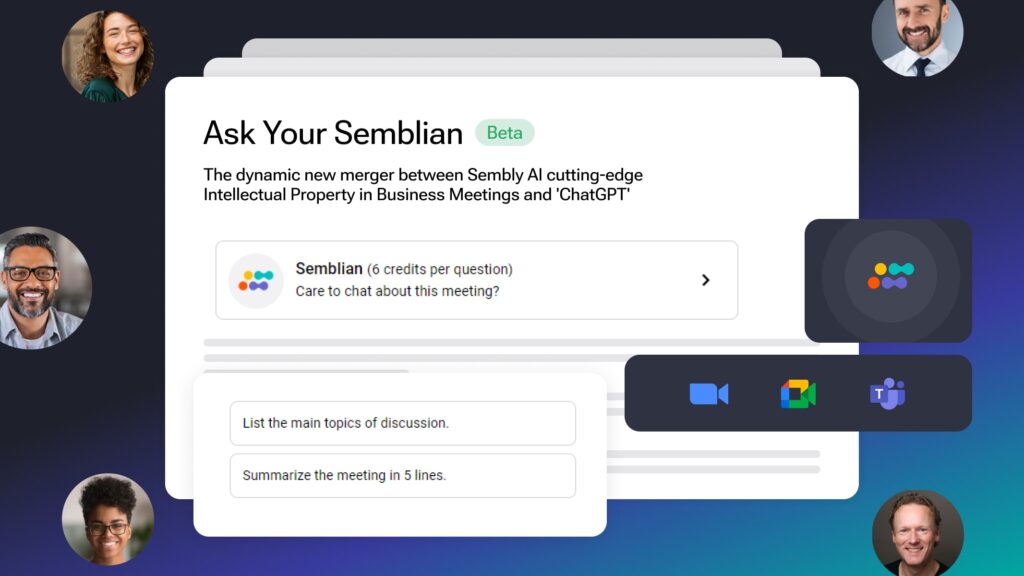
Sembly is an AI-powered meeting assistant that develops a deep understanding of you and your work by attending meetings along with you on popular video conferencing platforms such as Zoom, Microsoft Teams, Google Meet, and Webex. Sembly transforms meeting discussions into actionable insights, providing teams with a streamlined way to manage, share, and utilize meeting information without disrupting the flow of the meeting. Sembly eliminates the dependence on manual note-taking methods and post-meeting summarization, saving time and reducing important details being overlooked.
Sembly’s powerful automation features include the automatic generation of meeting summaries, action items, and key insights, significantly reducing the need for manual note-taking and post-meeting follow-ups. It integrates seamlessly with popular project management tools like Monday, Notion, and Asana, and CRM systems like Salesforce, enabling users to push meeting outcomes directly into their workflows, enabling teams with a complete automated history of interactions with customers and partners. Sembly also connects with personal productivity tools like Google Tasks and Microsoft To Do, and document management platforms such as Google Drive, Dropbox, and SharePoint, reducing or eliminating the need for manual task creation in these tools. For more customized automation, Sembly supports Zapier and webhooks, offering thousands of potential connections.
Semblian 2.0, an extension to the core Sembly product, further enhances automation by introducing powerful artifact generation capabilities. This includes automating the creation of comprehensive reports, feature requirements, sales proposals, and other key deliverables, leveraging the details from all discussions that Sembly attends. Semblian 2.0 streamlines some of the most time-consuming tasks, such as compiling status reports, and drafting documents, allowing teams to focus on higher-level decision-making rather than manual document preparation. This makes Semblian 2.0 an ideal solution for organizations who would like to automate time-consuming manual tasks and improve overall efficiency.
Pricing
Sembly annual plans start at $10/month. Semblian 2.0 is available as an add-on for an additional price. Price can vary based on selected plan and team size.
Pros and Cons
Pros:
- Automates data extraction from meetings
- Converts raw conversation data into structured workstreams
- Handles multiple languages for global teams
- Compatible with all the most popular video conferencing and project management tools
- Generates customized post-meeting action items
- Meets key data security standards
Cons:
- The Semblian 2.0 feature set comes at an extra cost
- Meetings held offline require extra steps to record and upload
- Risk of becoming too dependent on AI-generated outputs
Use Cases
- Automating sales data into targeted outreach strategies
- Turning project meeting notes into detailed reports and timelines
- Creating roadmaps from technical discussions
- Developing HR plans based on the date from employee feedback sessions
- Synthesizing data from various meetings for executive discussions
2. Zapier
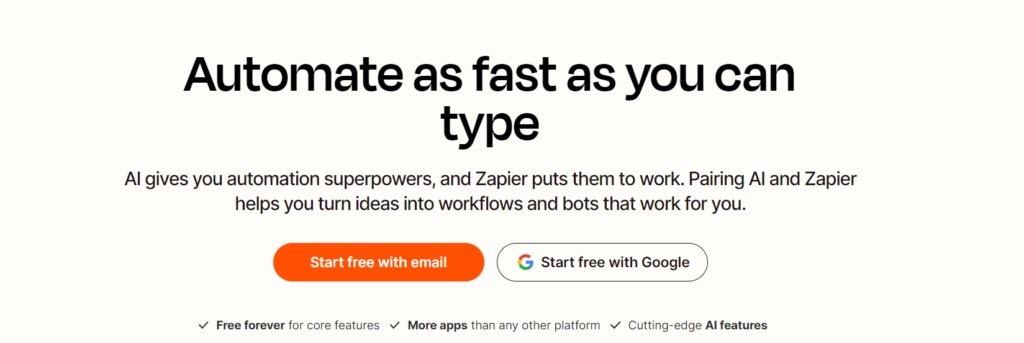
Now, let’s look at arguably the most popular automation tool with broad functionality, Zapier. Zapier is a no-code automation platform that connects over 7,000 apps, enabling users to create automated workflows known as “Zaps.” It streamlines data transfer between applications, eliminating mundane tasks and boosting productivity. Zapier’s user-friendly interface allows for the creation of custom automation without coding, making it easier for business users of all sizes to centralize data management and streamline operations.
With its extensive library of integrations, Zapier can automate processes across various departments, from marketing and sales to finance and human resources. This versatility, combined with its intuitive design, has made Zapier a go-to solution for businesses looking to improve efficiency and reduce manual data entry errors.
Pros and Cons
Pros:
- Extensive third-party app integration;
- User-friendly interface that doesn’t require knowledge of coding;
- Complex workflow automation capabilities for a wide range of needs;
- Customizable notifications and data formatting;
- Free tier for basic automation needs.
Cons:
- High pricing for advanced features and larger teams;
- The functionality of the free version is somewhat limited;
- Customer support availability varies;
- Dependence on third-party integrations;
- The learning curve for complex automation may be steep for individuals without a technical background.
Pricing
Zapier offers a free plan that includes the very basic features and allows you to build 5 Zaps, a starter plan for $19.99/month and 20 Zaps, a team plan for $299/month, and a company plan with custom prices for enterprises based on the usage of the tool.
Use Cases
- Automating lead capture from web forms to CRM systems;
- Syncing data between marketing and sales platforms;
- Sending automated follow-up emails after customer interactions;
- Centralizing project management updates across different tools;
- Creating reports by aggregating and processing data from multiple sources.
3. UiPath

UiPath is a leading robotic process automation (RPA) platform that enables businesses across the world to automate repetitive manual tasks within various applications and systems. With its user-friendly interface, it allows for the creation of workflows that extract, process, and analyze data from multiple sources, including legacy systems and web applications. UiPath offers a multitude of useful automation tools, such as ‘UI automation’ and ‘API automation’, making it a versatile tool for different automation needs, from simple data entry to complex data processing tasks.
UiPath also enhances data quality and compliance through automated testing and validation processes. Its integration capabilities allow businesses to connect disparate systems, streamline data flows, and improve operational efficiency, ultimately leading to faster decision-making and increased productivity.
Pros and Cons
Pros:
- Comprehensive integration with numerous applications and systems;
- The interface is user-friendly and intuitive for both technical and non-technical users;
- Strong capabilities for complex workflow automation;
- Advanced features for data quality testing and compliance;
- Scalable architecture for growing automation needs
Cons:
- The learning curve may be steeper compared to the previously mentioned Zapier;
- Some users have noted complications with the reporting systems;
- Limited debugging capabilities;
- Complex licensing structure;
- High licensing costs for small to medium-sized businesses.
Pricing
Pricing depends on the plan. UiPath offers a free plan for individual use, a pro plan, starting at $420/month, and an enterprise plan with custom pricing based on deployment scale and features.
Use Cases:
- Streamlining financial reporting by integrating data from various inner sources;
- Enhancing customer service through automated responses and data processing from their requests;
- Supporting legal compliance with automated data validation and quality checks;
- Facilitating data migration between legacy systems and modern applications.
4. Microsoft Power Automate
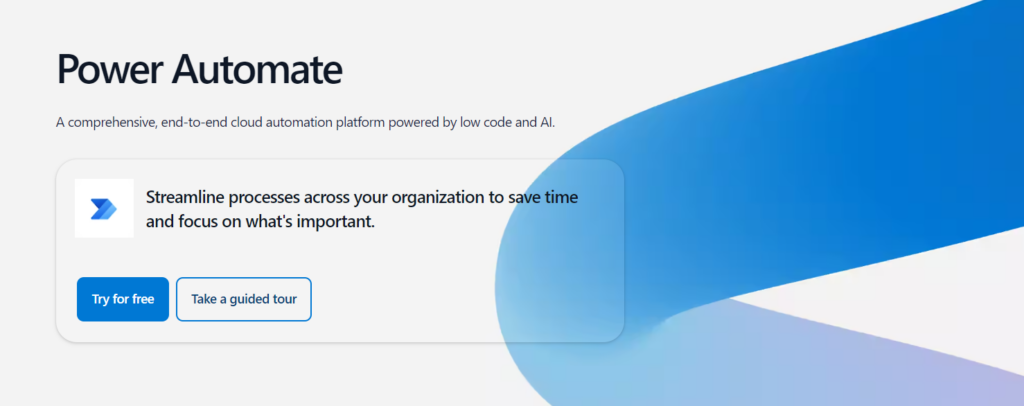
Here we have a cloud-based automation tool, but this time it’s a Microsoft product. Power Automate seamlessly integrates with Microsoft’s entire ecosystem, be it Office or Teams, and supports RPA for legacy systems. Microsoft Power Automate offers a low-code interface, making it accessible to users without extensive programming skills (however, you may still face situations where basic programming skills are required because the solution is low-code, not completely no-code). With a vast library of connectors, Power Automate enables the automation of complex processes across different systems, enhancing operational efficiency for organizations of all sizes, but still, this is a somewhat limited solution that fits businesses already relying on Microsoft’s ecosystem.
Pros and Cons
Pros:
- Extensive integration with Microsoft’s software and other third-party applications;
- User-friendly low-code interface;
- Large library of pre-built templates;
- Scalable for various business needs.
Cons:
- Limited capacity in the free version;
- Complexity in overseeing and managing numerous workflows;
- Limited use potential outside the MS Office environment;
- Power Automate supports only sequential workflows, limiting flow frequency;
- Limited customization options.
Pricing
Power Automate has a free plan based on a 30-day basic features trial with limited functionality, a Premium plan for $15 per user/month, and various pay-as-you-go plans for enterprises.
Use cases:
- Automating data collection from web forms to your databases;
- Automating email notifications for new SharePoint list items or creating tasks in Microsoft Planner based on emails received in Outlook;
- Power Automate can facilitate document approval workflows by routing documents to the appropriate stakeholders for review and approval, sending reminders, and notifying users of the status of their submissions;
- Power Automate can be used to synchronize data between different apps, such as updating a database with new entries from a CRM system or generating reports by aggregating data from multiple sources into Power BI.
5. Tray.ai
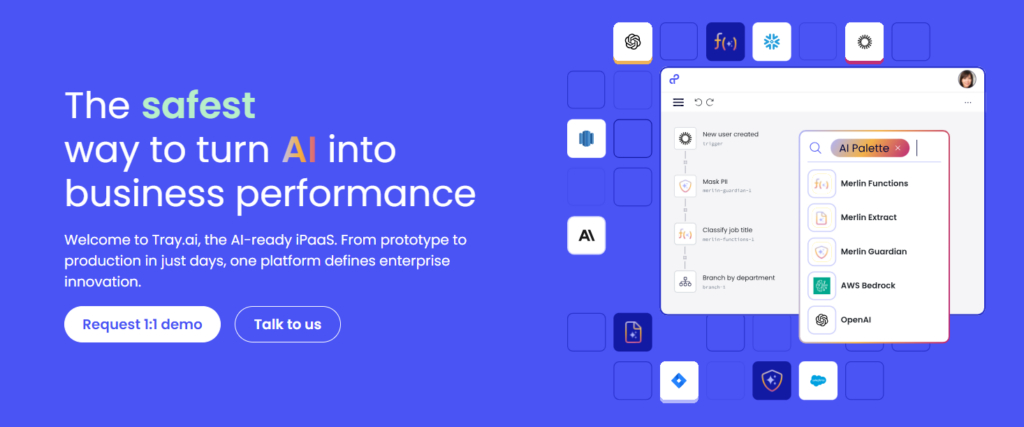
Tray.ai is an AI-ready integration Platform as a Service (iPaaS) that enables users to automate workflows and integrate applications across various systems. The main feature of Tray.ai is the easy integration. It’s a low-code AI-augmented builder that allows both business technologists and developers to create and adapt intelligent automation solutions quickly. With an extensive connector library (integration is again one of the main features of Tray.ai), composable architecture, and enterprise-grade security features, Tray.io offers a reliable platform for managing integration and automation initiatives.
Pros and Cons
Pros:
- Powerful automation features, including conditional logic, data mapping, and error handling;
- Comprehensive debugging and logging with search functionality;
- Flexibility to add custom code using the powerful JavaScript and Node.js connector;
- Extensive library of pre-built connectors for popular apps like Salesforce, HubSpot, Slack, etc;
- Scalability and flexibility to handle increasing workloads and evolving business needs.
Cons:
- Higher pricing compared to other similar iPaaS solutions;
- The steep learning curve for users without coding and low-code development experience;
- Limited functionality of the free version;
- Limited customization options.
Pricing
Tray.ai offers custom pricing based on three main factors: plan + usage + add-ons. For instance, for businesses with around 200 personnel, you should anticipate spending between $20,800 and $33,700 annually.
Use Cases
- Intelligent lead management with AI-powered data processing;
- Automating IT onboarding processes;
- Deploying embedded integration marketplaces;
- Creating autonomous support agents for IT tickets;
- Optimizing order-to-cash processes with AI-driven data extraction.
6. Stitch Data
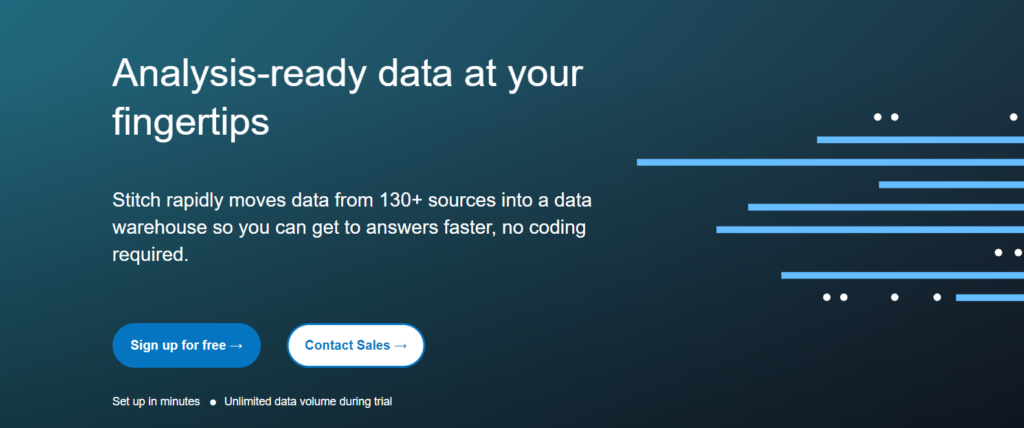
Stitch Data is the next candidate on our list of best data automation tools. It is a cloud-based platform that simplifies data integration by moving information from various sources into data warehouses for analysis. It offers over 140 pre-built connectors to third-party SaaS applications and databases, automating the extract, transform, and load (ETL) process. Stitch’s user-friendly interface and ready-to-query schemas allow data teams to quickly add new data sources without extensive technical knowledge, freeing up resources for insight-driven decision-making.
Pros and Cons
Pros:
- Large library of pre-built connectors;
- Fully managed, scalable service;
- Stitch automatically replicates data from the source to the destination, ensuring that the target database is always up to date.
- Intuitive interface;
- Users can quickly onboard new data sources and start querying data in minutes;
- Enterprise-grade security features.
Cons:
- Stitch employs a row-based pricing model, which can become expensive for organizations dealing with large volumes of data;
- Limited data transformation capabilities;
- Some users have reported that Stitch may not scale efficiently to handle increasing data volumes and complexity;
- Although Stitch supports a good number of connectors, it may not always keep pace with new data sources or integrations;
- Delays in customer support responses are possible.
Pricing
Stitch offers a free trial and custom plans based on monthly data volume and connected sources, featuring a reasonably priced calculator. However, users still need to contact sales directly for specific pricing details
Use Cases:
- Automating data extraction from web forms and APIs for lead generation;
- Syncing e-commerce platforms with inventory management systems;
- Integrating marketing tools with analytics platforms for campaign analysis;
- Enhancing customer profiles by connecting multiple data sources.
7. Hevo Data
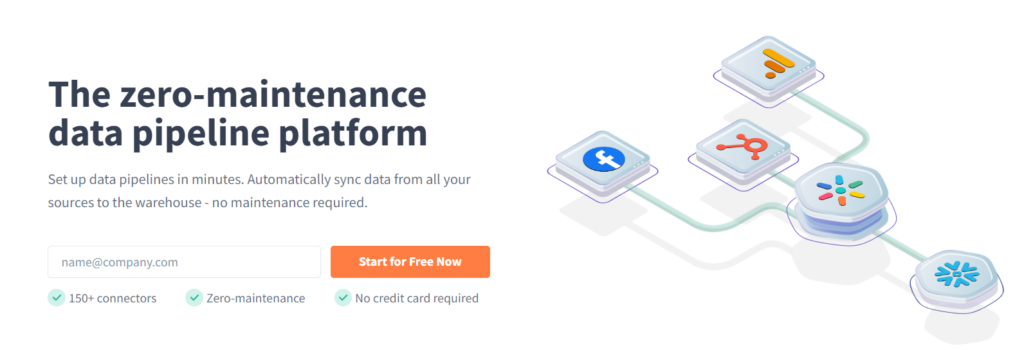
Similar to the previous tool, Stitch Data, Hevo Data is another automated platform that simplifies the process of moving data from over 150 sources into data warehouses. Hevo Data focuses on easy setup and maintenance-free operation, allowing organizations to create data pipelines quickly without deep technical knowledge. It supports real-time data loading and transformation, providing businesses with current information for analysis and decision-making. Hevo’s no-code approach makes it accessible to non-technical audiences while still offering robust data features
Pros and Cons
Pros:
- Over 150 pre-built connectors for data integration;
- Zero maintenance setup with automatic data syncing;
- Real-time data loading and transformation;
- User-friendly, no-code interface;
- Excellent customer support and documentation;
- Strong security and compliance standards.
Cons:
- Limited scheduling options for pipeline jobs;
- Confusing data transformation processes for some users;
- High CPU usage was reported during data processing;
- Inability to edit established pipelines without recreating them.
Pricing:
Hevo Data offers various pricing plans, including a free plan with access to essential features and limited connectors, a starter plan starting at $239/month for 5 million events, tiered pricing for higher volumes, and custom plans for larger organizations with specific data needs.
Use Cases:
- Automating the extraction and loading of data from multiple SaaS applications into data warehouses;
- Streamlining analytics processes by ensuring timely data availability for business intelligence tools;
- Facilitating data transformation and preparation for real-time analytics;
8. Workato
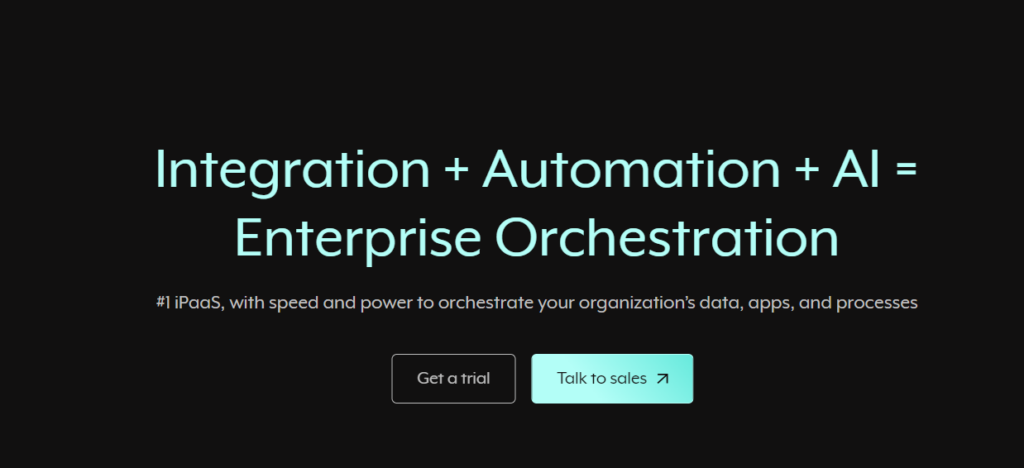
Another platform on our list, Workato, connects business apps and automates workflows through “recipes”, predefined steps that link tasks across different platforms. Its data orchestration tools manage pipelines from ingestion to monitoring, all in one place. The no-code interface perfectly suits non-technical users, while robust features cater to data teams seeking scalable automation.
Pros and Cons
Pros:
- Workato supports complex business logic, multi-step workflows, conditional actions, as well as bi-directional workflow automation for eliminating duplicate records across systems;
- Provides users with highly reusable workflow recipes;
- 300+ pre-built connectors;
- End-to-end data pipeline management.
Cons:
- Limited customization options;
- Resource-intensiveness;
- Complexity for advanced use cases;
- Support limitations.
Pricing:
Workato provides custom quotes based on organizational needs. Subscription fees for Workato typically range from $15,000 to $50,000 per year; however, the exact amount depends on usage. For the basic Workspace tier, subscription fees can reach up to $17,500/year. Also, Workato offers free trials.
Use Cases:
- Integration of document signing services like DocuSign with cloud storage solutions such as Box. Workato can monitor DocuSign for newly signed documents and automatically store them in Box, streamlining document management processes;
- Syncing data between CRM, ERP, and marketing tools;
- Automating approval processes across systems;
- Real-time data updates between cloud and on-premises apps;
- Automation of order processing by connecting e-commerce platforms with inventory management systems.
9. Fivetran
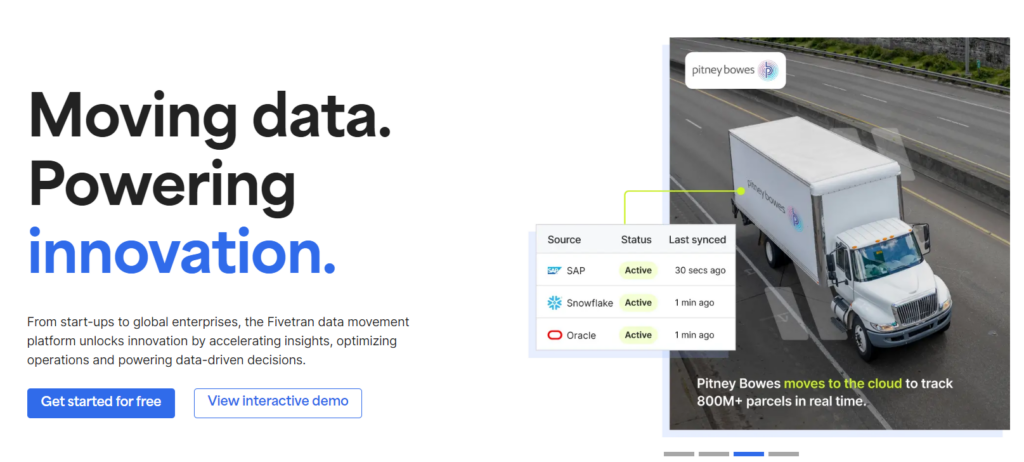
Fivetran is another tool on our list that helps move data from over 150 sources to cloud warehouses using ELT. It handles schema creation, data mapping, and drift detection automatically. The platform offers pre-built data models and supports dbt transformations, making data preparation for analysis easier. This approach lets teams access insights faster and spend less time on pipeline maintenance.
Pros and Cons
Pros:
- Predictable and easy-to-use tool;
- Automated schema handling;
- Dbt transformation support;
- Scalable data loading;
- Reliable pipelines with restart options.
Cons:
- Fivetran’s pricing is based on Monthly Active Rows (MAR), which may lead to unexpected cost increases if data volumes spike unexpectedly due to factors like seasonal changes or campaigns;
- While offering a user-friendly interface and pre-build connectors, Fivetran lacks the advanced customization options compared to its competitors mentioned previously;
- Connector limitations.
Pricing:
A basic pricing model is MAR-based, meaning pricing depends on data volumes. Costs range from $120 (a starter plan for 200k MARs) to $3,000 monthly for typical projects.
Use Cases:
- Companies like Canva use Fivetran to integrate data from multiple marketing platforms, such as Facebook and Google, allowing them to analyze campaign effectiveness and customer behavior;
- Raiffeisen Bank International leverages Fivetran to streamline data operations across multiple countries, enhancing their multi-channel marketing performance by 60%;
- Saks, a luxury e-commerce platform, uses Fivetran in conjunction with Snowflake and dbt to enhance operations efficiency (optimizing inventory and improving the customer experience);
- Deliveroo automates data movement with Fivetran, improving engineering efficiency and leading to significant cost savings.
10. Informatica PowerCenter

Another data integration and automation tool we have today is Informatica PowerCenter. It focuses on managing data workflows and building data warehouses. Informatica PowerCenter helps automate ETL processes, bringing data from various sources into one central system, and a wide range of other data-associated tasks. PowerCenter’s PMCMD tool lets IT teams script commands to handle workflows, cutting down on repetitive tasks. The platform works with many data types and sources, including cloud apps. It offers data quality checks, real-time processing, and advanced transformations, helping businesses turn data into useful insights.
Pros and Cons
Pros:
- Comprehensive ETL capabilities;
- Robust data quality management;
- Real-time and batch processing;
- Extensive monitoring and error handling;
- PowerCenter offers comprehensive tracking and management of metadata.
Cons:
- The extensive feature set can be overwhelming;
- Limited real-time processing;
- Resource-intensive;
- It is not as easy to use as the other data automation software on our list.
Pricing:
PowerCenter uses custom pricing based on users, data volume, and the specific needs of your business. Costs include annual fees and setup charges.
Use Cases:
- Extracting data from operational systems and transforming it into formats suitable for reporting and analysis in BI environments;
- Facilitating integration of disparate enterprise applications by extracting and transforming data for smooth data flows;
- Automated data migration from legacy systems to modern applications;
- Extracting data from heterogeneous sources, transforming it, and loading it into a data warehouse for reporting and analytics.
11. Apache NiFi
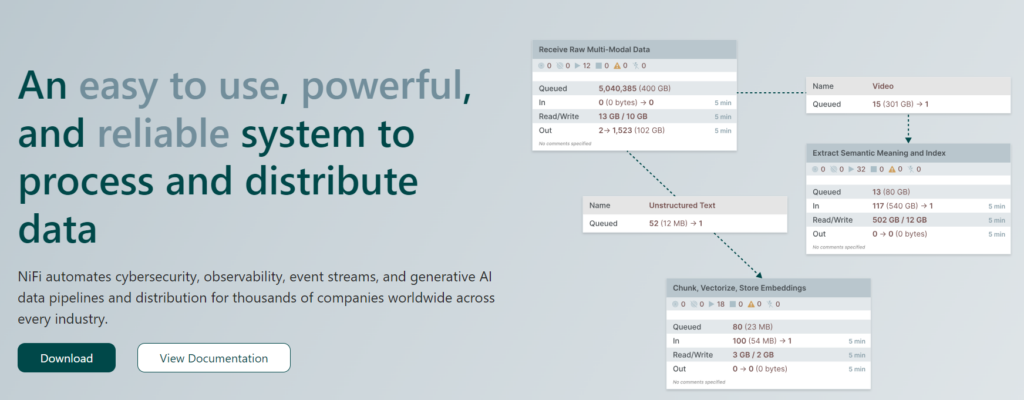
Apache NiFi is an open-source platform for moving data between systems in real time. It offers a web interface where users can design and monitor data flows visually. NiFi handles various data types and sources, making it useful for tasks from ETL to IoT data management. Its key feature is data provenance, which tracks data from start to finish. This helps maintain data integrity and makes it easier to audit changes. NiFi’s flexibility suits many data processing needs, from batch to real-time.
Pros and Cons
Pros:
- Easy-to-navigate intuitive interface;
- Ability to handle real-time and batch data;
- Ability to track data lineage;
- Working with a vast array of data types;
- Strong security features;
- Support for multiple data sources and protocols;
- Robust security features;
- Prioritized queuing.
Cons:
- Complex initial configuration;
- Limitations in terms of advanced debugging;
- Visual clutter in complex flows;
- Potential performance issues with large data volumes.
Pricing:
Unlike the previous data automation platforms, NiFi is free to use as open-source software. Costs may include infrastructure support and maintenance for production use. Some vendors offer paid support or managed services.
Use Cases:
- Ingesting data from various sources (including IoT devices) into data lakes or data warehouses for storing and analytics;
- ETL implementation;
- IoT data management with real-time data streams from IoT sensors and devices;
- Replicating data between databases, data lakes, and data warehouses for backup, disaster recovery, and reporting;
- Monitoring data flows and triggering alerts based on predefined conditions or thresholds;
- Tracking the complete lineage of data from source to destination for compliance and auditing.
How to Implement Data Automation Tools in Your Business
Implementing any of the data automation platforms mentioned today can fundamentally transform your business operations. Although the specific approach will depend on the tool you choose, here’s a versatile approach to implementing data automation in your business:
Start by assessing the current situation with data in your company and identifying pain points that automation could address. Common use cases include streamlining integration between systems, automating the ETL process, and centralizing data for further analytics.
When evaluating tools, look for ones with extensive connector libraries that meet your needs, user-friendly interfaces, and robust data provenance features. Consider how well the platform scales to handle data volumes your business needs and adapt to future business needs. Prioritize ease of use, as it will encourage wider adoption across your organization. Lastly, ensure that the tool integrates seamlessly with your existing technology stack and offers reliable support. A well-planned implementation can unlock data-driven insights and free up your team to focus on more strategic initiatives.
The Future of Data Automation
The future of data automation is poised for transformative advances that can be felt across the entire tech sector. Organizations can now harness their data with unprecedented agility that was never seen before. However, this is likely not the limit. Let’s take a closer look at the range of exciting trends unfolding in the upcoming years that will impact how the process of data automation looks and feels:
- AI-powered automation: In recent years, using AI to automate increasingly sophisticated data workflows and generate predictive intelligence that drives strategic decision-making is likely to become quite common;
- Serverless architecture: We will probably see more of a simplified, cloud-based infrastructure that reduces maintenance overhead, allowing data teams to focus on building value-adding automation rather than fixing architecture issues;
- Deeper expansion of no-code/low-code tools: These tools enable business users to create data automation solutions without deep technical expertise, democratizing data integration across businesses and organizations, thus we expect to see them used more widely;
- Event-driven pipelines: Real-time data flows that react to triggering events enable organizations to adapt to changing conditions rapidly, there is significant potential for further expansion across the data automation field;
- Blockchain for data provenance: Applying blockchain technology to enhance data lineage, security, and auditability can help organizations ensure the integrity of automated data processes. So, blockchain in data automation is another potential trend for the coming years.
- More IoT data integration: The seamless incorporation of sensor data into enterprise data automation strategies unlocks insights from the expanding Internet of Things. So, we will expect to see even more data from IoT devices.
Summary of Key Points
Data automation is the field that transforms how businesses handle information. As of 2025, dozens of tools are available for companies and organizations. These tools automate repetitive tasks, reduce errors, accelerate data processing, and handle most data operations. Choosing the best tool for your needs can be quite challenging; however, knowing what to look for can significantly ease the process.
When selecting the right data management tool, key considerations may include ease of use, integration capabilities, security, customization options, and support availability. The 11 tools presented today offer a range of features and benefits to address different business needs, from AI-powered meeting assistants to open-source data integration platforms, for virtually any type of business, from startups to well-established enterprises. However, the most important aspect of selecting the right tool is still understanding your organization’s specific needs and long-term objectives. Although the options may seem overwhelming, understanding your needs and other evaluation criteria can guide organizations to the solution that best supports their data-driven decision-making.
FAQs
What is data automation?
Data automation is the process of using technology to handle data-related tasks with no or minimal human intervention.
Why is data automation important for businesses?
Data automation streamlines repetitive processes, reduces errors, and enables faster, more informed decision-making, overall significantly impacting the efficiency of the business processes.
What are the key components of data automation?
The key components include data collection, storage, cleaning, integration, processing, analysis, reporting, and workflow automation.
What should businesses look for when choosing a data automation tool?
Key considerations include ease of use, scalability, integration capabilities, security, customization options, and availability of support. Understanding these considerations along with your specific business needs will guide you toward the tool that best suits your business model.
What types of automated data solutions are available?
The market in 2024 offers a wide range of tools, including ETL platforms, RPA solutions, low-code/no-code integration platforms, AI-powered assistants, etc.
What are the most famous data automation companies?
Today, we have discussed the 11 most popular tools for data automation in 2024. The list of solutions selected by us includes Sembly, Zapier, UiPath, Microsoft Power Automation, Tray.ai, Stitch Data, Hevo Data, Workato, Fivetran, Informatica PowerCenter, and Apache NiFi.
Meet Semblian 2.0
- ✦ Multi-Meeting Chats
- ✦ AI Insights
- ✦ AI Artifacts
